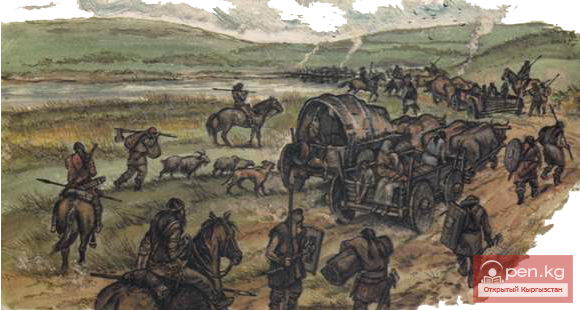
"Hudud al-Aalam" about the "Priirtysh" Kyrgyz
In the chapter "Words about the mountains of 'Hudud al-Aalam' and the mines that are in them," it is stated: "And there is another mountain (located) in the northern region, between the border of the Kimaks and the beginning (of the settlement) of the Khyrgyz. It goes from the very border of the Kimaks and stretches in an eastern direction to the border of the Khyrgyz, then turns and descends to the northern areas, to those very places where the populated (regions) of the world end. In the northern regions, the Kimaks call this mountain Kandaï urbagi." It is likely that this message referred to those Kyrgyz who, according to Al-Istakhri, could inhabit areas somewhere in Eastern Kazakhstan, the southern Altai, and northern Dzungaria. This group of Kyrgyz, who were probably also among the "Western" Kyrgyz, can conditionally be called the "Priirtysh" Kyrgyz. In another part of this work, there is mention of a river called Ras. "(It) flows in the northern limits and through the land of the Guzz. This is a large (river), but muddy and foul-smelling. It originates from a mountain located on the border between the Kimaks and the Khyrgyz, crosses the land of the Guzz, and flows into the Caspian Sea." Here, it is evident that information was being reported about the "Priirtysh" Kyrgyz, who, according to this data, apparently resided in the north of Dzungaria. It is quite possible that the Kimak tribes conquered the Kyrgyz living in the areas of Priobye, Altai, and Priirtyshye, and perhaps partly pushed them toward the Yenisei and to the north of Dzungaria.
This position may also be confirmed by the information from Al-Idrisi ("Nuzhat al-Mushtak fi Ikhtiraq al-Afaq", 12th century), who reports: "All the cities of the land of the Khyrgyz are concentrated in one territory, the length of which is about three marhalas. There are four large cities, surrounded by walls and fortifications, and populated by zealous, brave, and courageous people, who especially have to fear the actions of the lord, the warlike prince, who is almost always at war with his neighbors." It is clear that this information pertains to an earlier time than the first half of the 12th century. In this information, it is evident that both the "Western" and "Eastern" Kyrgyz were being referred to. Thus, further in Al-Idrisi, it is stated: "In this land (of the Kyrgyz - E. u. K) they breed many horses, bulls, and sheep. The horses have very short necks and are quite well-fed. They are fattened for consumption. As for the bulls, they are usually used for transporting heavy loads. Women perform all kinds of work, while men are supposed to engage only in plowing and harvesting.
Women possess agility, strength, and courage, like men. The Khyrgyz burn their dead and throw the ashes (into the river) Manhaz; those who live too far from this river collect their ashes and scatter the dust to the wind."
About the land of Khyrgyz (Kyrgyz), it is also reported that "it is very fertile, visited by travelers. This land is rich in water. It has various rivers flowing from the border of China.
The largest of these rivers is the one called Manhaz. This river is abundant in water and fast-flowing. It flows over stones, and its waters rarely flow calmly, as is the case with other rivers. They (the Khyrgyz) have mills on this river, where they grind rice, wheat, and other grains, turning them into flour, from which they make bread, or they eat them boiled without grinding; this is their sustenance. On the banks of this river, the aloe tree grows. It is home to a fish called ash-shatrun, which has the same effect on the reproductive organ as assankur, which is found in the Nile in Egypt; it is said that this fish has few bones, and its meat is flaky and does not have the odor characteristic of fish."
It is quite possible that the Kimak tribes could have conquered the "Eastern" Kyrgyz living in Altai, Priirtyshye, and Priobye, partly pushing them toward the Yenisei. The remnants of the "Western" Kyrgyz could have migrated to the north of Dzungaria.
It is quite possible that the Kimak tribes also conquered the "Western" Kyrgyz, although they may have only conquered part of this group of Kyrgyz, while another part could have resided in the north of Dzungaria.












































